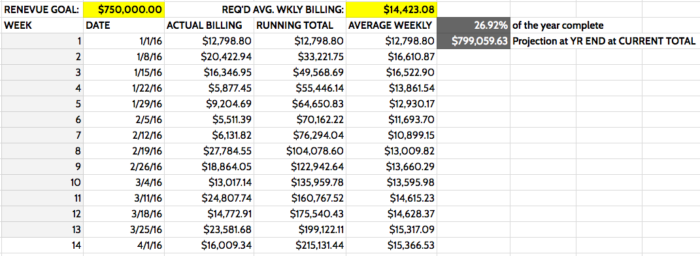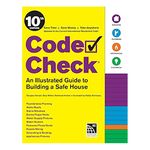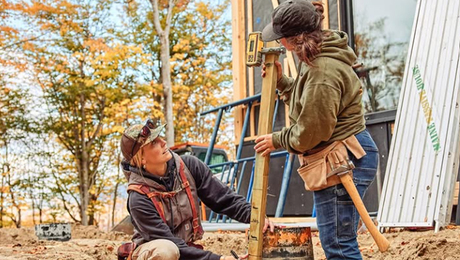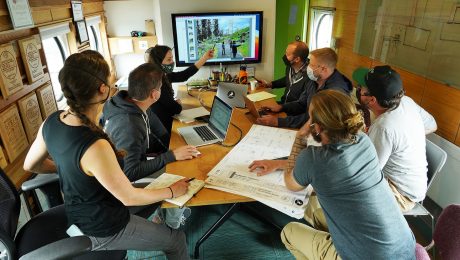Fast, Accurate Techniques for Estimating Construction Costs
In order to quickly produce accurate construction estimates, you need to develop a unit-cost method for estimating your construction projects.

Hitting the bull’s eye for any construction company should be to deliver quality service and craftsmanship for a price that yields the profits needed to sustain the business.
The way construction businesses achieve this goal is providing fast, accurate estimates for the services and products they provide.
Estimate a construction project
There is a two-step process for estimating every construction project:
Step 1. Determine Your Costs.
Step 2. Apply a Markup that will yield the appropriate profit after expenses.
It is that simple, but it is not that easy if you don’t have a systematic process for producing an accurate estimate in a short amount of time.
The speed and accuracy at which you perform the steps above will directly influence the closing rate and potential profitability of your construction projects.
But before you can develop a fast, accurate system for estimating your construction projects, you need to stop doing a couple of things.
Stick estimating construction costs
Stick estimating (counting every piece of material and determining every hour of labor) is an accurate way to determine your costs, but stick estimating is extremely inefficient. Stick estimating can also lead to oversights if the project plans are not complete or you miss a scope item.
If you want fast, accurate estimates, then stop stick estimating.
Estimating construction costs by hand
The only technique more inefficient than stick estimating is estimating by hand. Even if you are detailed with your takeoffs, scope, and notes, you will still miss something or hit the wrong button on the calculator. Estimating by hand is prone to errors, is not repeatable, and a waste of your valuable time.
Unit cost estimating
If you want to produce fast, accurate construction estimates, then you need to develop a unit cost method for estimating your construction projects.
Combining a unit cost method with the correct estimating software is the fastest, most accurate, and cost effective way to produce construction estimates for your business.
What is the best construction estimating software?
I know this may seem vacuous, but the best estimating software for your construction business is the one that you will actually use.
Many good construction estimating programs are buried within bloated, complex, and expensive project management softwares. Although these software programs contain many useful project management tools, there is usually a steep learning curve prior to implementation.
Dedicating time to learning a new program is fine, if you have the time, the resources, and the personnel to do so.
I am a fan of many estimating programs, but only if you understand the input and the formulas the program uses to calculate the costs, profits, and prices for your projects.
You know the old saying, “Garbage in. Garbage out.”
If you need a system to produce fast, accurate estimates for your construction business, then you can use the techniques described below in a simple spreadsheet or in a packaged software program.
The core of every construction estimating program is the database of costs or pricing. Developing your own database of construction pricing does not have to be complicated. In fact, you might already have a database of information without even knowing it.
Developing a cost database for your estimates
In my previous article (Developing an Estimating Database), I discussed how to use the prices you receive from your subcontractors to develop a database of costs for their associated scopes of work.
Much like developing a database for subcontractor pricing, the steps listed below will help you develop a unit cost or unit price database for your construction business.
Note: A unit based cost does not include the markup. A unit based price includes the unit cost of the item with the markup applied.
Step 1 – Estimate the schedule-based unit price
In a previous article (Three High-Level Metrics…), I describe how you can use a simple number like Total Revenue to develop metrics that inform you about the health of your construction business.

Using that same number, Total Revenue, you can determine the unit price for a given period of time for your business.
Example:
If your Total Revenue was $500,000 last year, then the weekly price you produced was $9,615.
WEEKLY PRICE = $500,000 / 52 per yr = $9,615
Let’s assume that, in general, your company worked on one project at a time and then moved to the next.
When you get a call for your next project, you determine that will take about 5 weeks based on your experience.You can quickly estimate that the price for this job is around $48,000 (+/-).
SCHEDULE BASED UNIT PRICE = WEEKLY PRICE X ESTIMATED SCHEDULE
$9,615/wk X 5 weeks = $48,000
If your company has multiple crews working on multiple projects at any given time, you can factor that into the above calculations.
Step 2 – Estimate an assembly-based unit price
The stick estimating method accounts for every piece (materials in pieces or labor in hours). But there is no need to develop a material list or a labor takeoff until you have sold the job. Doing so is a waste of time.
A unit price method will account for the assembly of units that make up the project.
Example:
Stick estimating requires that you list labor and equipment costs for excavation, total number of rebar, labor for setting rebar, cubic yards of concrete, and labor for placing concrete for a foundation.
An assembly unit price for this foundation would include all the labor, materials, and markup for each linear foot of foundation or cubic yard concrete poured.
LABOR AS AN ASSEMBLY
If you are a specialty or subcontractor and mainly sell labor only, then your labor price can be an assembly too. (See my previous article – Developing a Base Rate and Calculating Your Labor Burden).
The Schedule Based Unit Price from the example in Step #1, helped us determine the approximate price of a 5-week project.
If we have determined that the unit price for an hour of labor is priced at $45/hr, then we can determine the labor price for a 3-person crew for a 5-week project as follows:
TOTAL LABOR PRICE = LABOR PRICE/HR/MN X CREW SIZE X HR/WK X # of WEEKS
TOTAL LABOR PRICE = $45/HR/MN X 3 X 40 X 5 = $27,000 LABOR PRICE
Once you have determined a schedule base price (Step #1) and an Assembly Based Unit Price (Step #3), you need to modify your price to take into account project specific factors such as customizations, specialty items, and difficulties that are not included in your unit prices.
Step 3 – Add factors to your unit prices
There are many factors that drive costs up on one project that may not be present on other jobs. A vital part of developing a system for fast, accurate estimating is developing a standard list of production factors that you will apply to your pricing.
From my previous article, Calculating the Labor Budget in Your Construction Estimates:
The production rate [assumes] we live in a perfect world where all we have to do is show up and install [the work]. The production rate does not account for all the setup, breakdown, site conditions, and other difficulties that we will encounter when installing [the work].
You may determine that certain types of jobs require additional time, effort, and methods to be constructed properly and profitably.
For example, difficult job site conditions could add as much as 10% to your costs. Even though you specialize in high-end custom work, a particular design might require as much as a 20% increase in your installation because of the fine level of detail required to install.
You do not work in a perfect world. Add factors to your unit cost pricing on a per job basis to account for working in the real world.
Step 4 – Compare the unit prices to relevant data
Every job you sell, perform and track is a data point in your construction company’s database. As you develop the database by tracking actual job costs, subcontractor costs, labor budgets, and compare those numbers to the techniques described in this article, your pricing database will become more and more accurate.
Revisit your database every month if you have less than one year’s worth of data (actual tracked costs).
Once you have a year’s worth of data in various forms then you can do a quarterly analysis and update.
Adjust prices when needed as driven by the data.
How to sell profitable construction projects
The more accurate your numbers prove to be over time, the more confident you will become in your estimating. Confidence in your estimating will not only increase the speed at which you produce your estimates, but will also help you close more sales. More accurately priced construction projects will mean more profits for your business.
When you know how your construction projects are priced, then you can perform the work in a manner that reflects the data used in the estimate.
Using your own database to price your construction projects is like using a laser sight to hit the target. Stop throwing darts.
…
Thanks for taking the time to read this article. I really appreciate and value your time. Please leave a comment below and let me know if you agree, disagree, or have any questions about this topic.
Follow me on Instagram @shawnvandyke, LinkedIn, Facebook, or shawnvandyke.com to learn more about how to streamline your construction business.
Fine Homebuilding Recommended Products
Fine Homebuilding receives a commission for items purchased through links on this site, including Amazon Associates and other affiliate advertising programs.

Get Your House Right: Architectural Elements to Use & Avoid

The New Carbon Architecture: Building to Cool the Climate

Code Check 10th Edition: An Illustrated Guide to Building a Safe House





























View Comments
wow just found this. informative and helpful especially for my line of work.
thank you!
https://www.cubitsestimating.com/
Calculating construction costs can be tricky, especially without any software. As a matter of fact, labor construction costs make up to 40% of the construction costs, so having a resource management software in place definitely is a great step towards better accounting. Check this article out: https://www.bridgitsolutions.com/construction-field-workforce-management
This is a very informative read! Thanks for sharing a step-by-step guide on how to make a unit price database that could really be helpful in coming up with an accurate estimate for a construction job. I also read a blog post that taught in great detail how one could calculate labor costs in construction using base rate and labor burden to accurately determine construction labor rates. Here's where you can learn more about it.
Great article.
I really like this post
Thank You for your information
https://www.prithu.in/
Construction cost estimation must be performed individually for each project. This approach is very different from assembly line manufacturing.
csiestimation
general advice on fast and accurate techniques for estimating construction costs, which could be applied in the context of the construction industry in Pakistan represented by zarea.pk. Here are some strategies:
Use of Cost Estimating Software: Invest in and utilize advanced cost estimating software that can streamline the process and provide accurate estimates based on project specifications, materials, labor costs, and other relevant factors. Such software can significantly reduce human error and improve efficiency.
Reference Similar Projects: Reference past projects similar in scope, size, and location to gauge potential costs. Adjustments can then be made based on differences in materials, labor rates, and other variables.
Consult Industry Experts: Collaborate with experienced construction professionals, architects, engineers, and contractors to gather insights and estimates. Their expertise and knowledge of local market conditions can provide invaluable guidance.
Detailed Quantity Takeoffs: Conduct detailed quantity takeoffs to accurately determine the quantities of materials, labor, equipment, and other resources required for the project. This meticulous approach ensures that all elements of the construction process are accounted for in the estimation.
Consider Contingencies: Incorporate contingencies into the cost estimate to account for unforeseen circumstances or potential changes in project scope. Industry standards often recommend a contingency allowance of 5% to 10% of the total estimated cost.
Regular Cost Updates: Continuously update cost estimates as the project progresses and new information becomes available. This proactive approach helps in identifying any cost overruns or deviations from the initial estimate early on, allowing for timely adjustments.
Benchmarking: Compare the estimated costs against industry benchmarks and standards to ensure competitiveness and accuracy. This can involve referencing published cost data or engaging in industry associations and networks to stay informed about prevailing market rates.
Utilize Online Resources: Take advantage of online resources and databases that provide access to cost data, material prices, and construction indices specific to the region. These resources can supplement internal estimates and enhance accuracy.
Value Engineering: Explore value engineering options to optimize project costs without compromising quality or functionality. This involves identifying opportunities for cost savings through alternative materials, construction methods, or design modifications.
Regular Training and Development: Invest in the continuous training and development of estimating teams to enhance their skills, knowledge, and proficiency in cost estimation techniques. This ensures that the estimating process remains up-to-date with industry best practices and methodologies.
By employing these techniques, zarea.pk can enhance the accuracy and efficiency of their construction cost estimation process, leading to better project planning, budgeting, and overall project management.